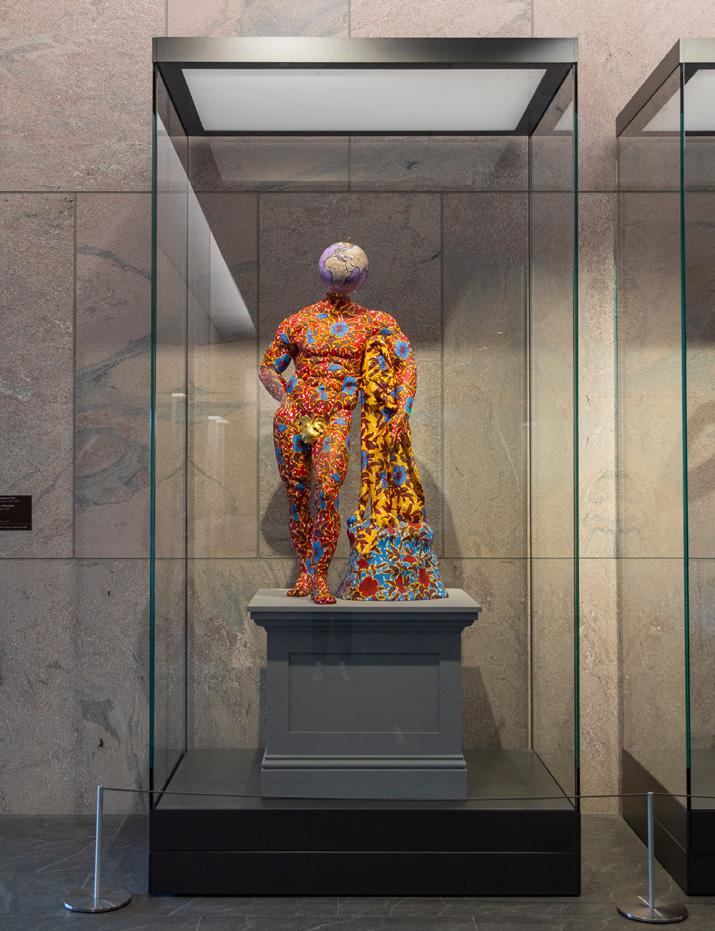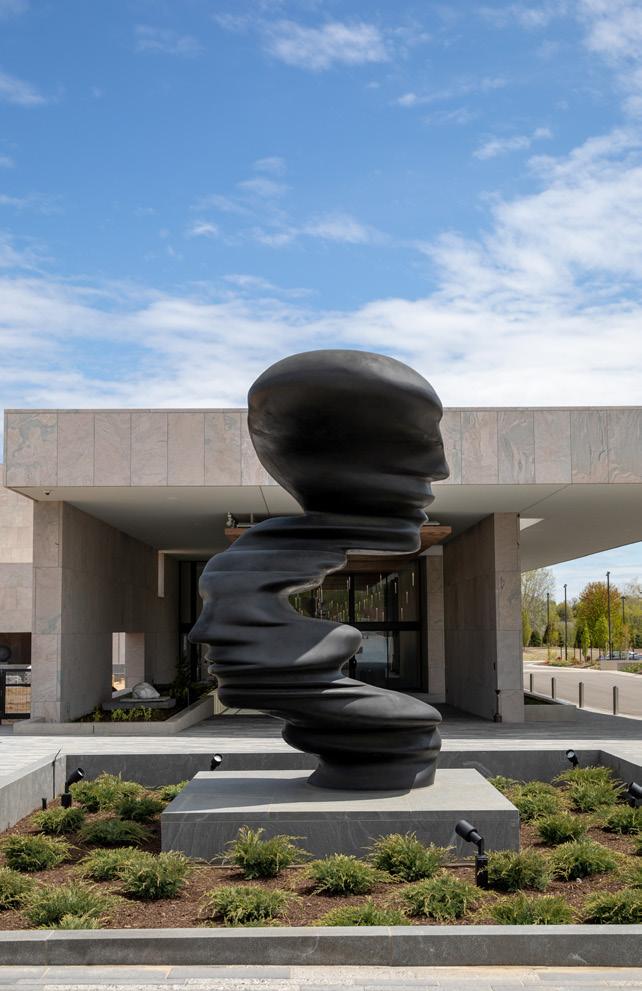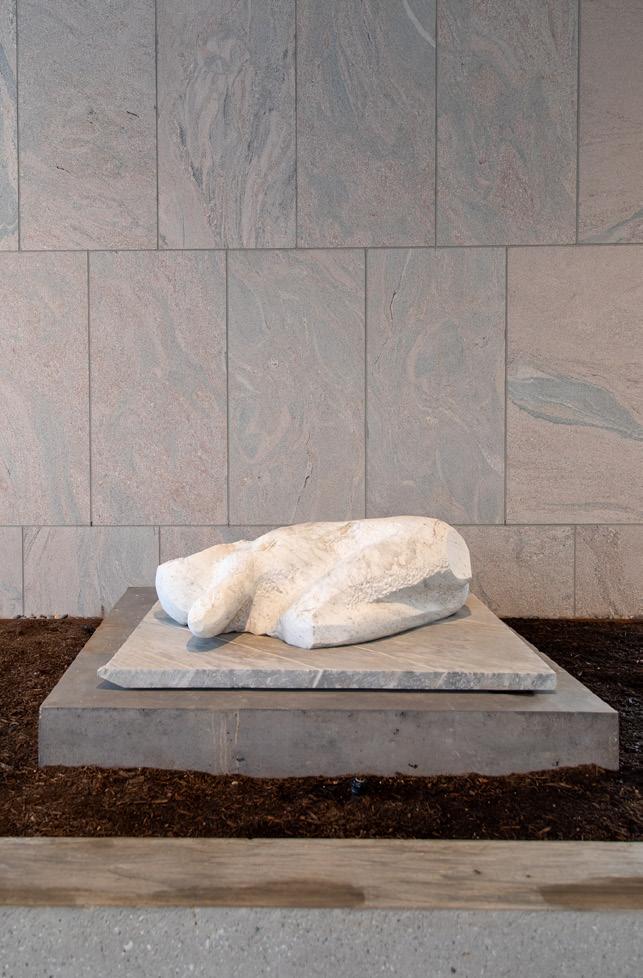
3 minute read
WELCOME CENTER SCULPTURE HIGHLIGHTS, PART 2
In addition to horticultural displays and architectural details throughout, the new Welcome Center features prominent works of sculpture by major international artists Jaume Plensa, George Segal, Yinka Shonibare CBE, El Anatsui, Alexander Calder and the artist who sparked Fred Meijer's passion for collecting sculpture, Marshall Fredericks. Part of the permanent sculpture collection, the placement of these works alongside horticultural vistas reflects our mission as evidenced throughout the Gardens & Sculpture Park. Read on to learn more about a few of the newly placed sculptures and the artists who created them.
YINKA SHONIBARE CBE. APHRODITE DE FRÉJUS, 2018 AND FARNESE HERCULES, 2017.
Advertisement
Born in London and raised in Lagos, Nigeria, Yinka Shonibare is one of the most recognized and distinguished British-Nigerian artists working today. Shonibare has exhibited around the world, including participation in important contemporary art exhibitions such as Documenta and Venice Biennale. Among his many public art projects is the prestigious public commission for Trafalgar Square in London. He was a nominee for the distinguished Turner Prize in 2004; in 2013, he was elected as Royal Academician; and in 2019, he was honored with the title of CBE or Commander of the Office of the British Empire which he has adopted as part of his name.
Referring to his dual identity as Nigerian and British, Shonibare is a self-described “post-colonial hybrid.” His art finds inspiration in art historical sources from Greco-Roman antiquity to African design. Welcoming guests as they approach the Daniel and Pamella DeVos Ticketing Center, Shonibare’s Aphrodite de Fréjus and Farnese Hercules are in conversation with classical statues, challenging Western ideals: Aphrodite or Venus, the goddess of love and beauty, and Hercules or Herakles, the hero of the Twelve Labors. Both antique sculptures are on display at the Musée du Louvre in Paris. Shonibare reimagines them with his signature Dutch wax batik patterns painted on the surface. He gives each sculpture a new postcolonial interpretation by playfully turning their heads into globes and showing the African continent where the face would be, adding contemporary meaning and a context to explore race and power.

Yinka Shonibare CBE. Aphrodite De Fréjus, 2018.
Kirstin Volkening

Yinka Shonibare CBE. Farnese Hercules, 2017.
Kirstin Volkening
TONY CRAGG. BENT OF MIND, 2005.
Born in Liverpool, England, Tony Cragg is an internationally recognized sculptor whose work is collected by major museums around the world. Growing up in Great Britain, Cragg first pursued a career in science before studying art. In the 1970s, he moved to Wuppertal, Germany, where he still lives and maintains a studio. He has held several teaching positions and directorships at distinguished art schools over the years, including the Art Academy of Düsseldorf and the University of Arts in Berlin. His early work consisted of assemblage sculpture, using plastic and other found material. Over the past few decades, Cragg has been constantly searching for new materials that allow him to push the language of sculpture.
Tony Cragg eventually turned toward the traditional medium of bronze, which the artist considered archaic but also full of potential to push the relationship of material, creativity and the human mind. Cragg is now well-known for his large bronze and stone columns which reveal faces as you move around them. Bent of Mind is one of his most ambitious bronze sculptures; two separate faces come into view as if the column has shifted off center into different directions. It welcomes guests on the Frey Foundation Plaza before they enter the Welcome Center.

Tony Cragg. Bent of Mind, 2005.
Kirstin Volkening
MANUEL NERI. ODALISQUE IV, 1994.
Manuel Neri is considered one of the great American figurative sculptors of the twentieth century. Born in California to Mexican parents who were farm laborers, Neri studied art in the San Francisco Bay area where he later taught for many decades. He first received national recognition in the 1950s as part of a group from California known as the Bay Area figurative artists. His work is now in major museum collections across the United States.
In 1981, Neri opened a studio in Carrara, a city in Italy known for its rich marble deposits quarried since the days of ancient Rome. The sculpture Odalisque IV, placed inside the PNC Portico, is a great example of the artist’s skillful carving technique, alternating smooth and polished surface treatment with rougher chisel marks. The figure in Neri’s Odalisque IV has a deep reclining posture with intense gesture, her knees and arms forming angular counter movements to the torso. Neri here translated an ancient material and art historical theme into contemporary expressionistic form. This sculpture has been relocated from the Sculpture Park to better protect its delicate material from the elements.

Manuel Neri. Odalisque IV, 1994.
Kirstin Volkening







